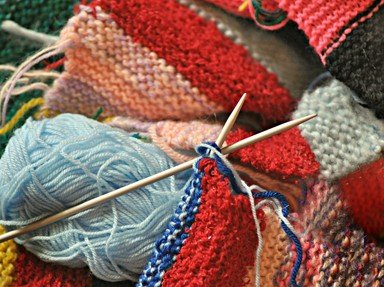Quiz Answer Key and Fun Facts
1. Woollen Grasshopper, unique styles of both martial arts and knitting originate in almost every part of the world. The arts of Dirk Dancing and Bhata, and the styles of Aran and Fair Isle, all come from which area?
2. Woollen Grasshopper, in some martial arts a reach, snatch and pull-back movement of the non-punching arm is used to balance an advancing blow. In what productive way can an exponent of 'extreme crochet' make use of a similar arm movement?
3. Woollen Grasshopper, Rumi Maki is an Incan martial art divided into five levels. Two of these levels share their names with very popular fibres used for spinning into knitting yarn. Which animals are the sources of both?
4. Woollen Grasshopper, controversy is never far away from martial arts in one form or another, but it can also hit crafting circles. Which phrase - long-associated with social crafting groups - was the subject of heated debate and legal action in the early 21st century?
5. Woollen Grasshopper, murder mystery stories involving martial arts are not at all rare, but those involving crafts are much more difficult to find. Which of these is NOT a 'Crochet Mystery' written by American author Betty Hechtman?
6. Woollen Grasshopper, spinning and turning feature in martial arts as kicking movements. Fibre obviously needs to be spun before it can be used for knitting, but what kind of 'turning' is specifically a knitter's nemesis?
7. Woollen Grasshopper, the Ninja of Japan were masters of not being seen, and there are textile activists who work by stealth too. What is the name given to guerrilla-style raids in which public spaces are 'decorated' with knitted or crocheted items?
8. Woollen Grasshopper, spiritualism plays an important part in the study of many martial arts. What is the title of a book which explores the spiritual aspects of knitting?
9. Woollen Grasshopper, the Sikhs practice Gatka Punjabi, and the Norse the art of Stáv. What do they share with the international yarn art known as 'extreme knitting'?
10. Woollen Grasshopper, a teacher - or sensei - is very important in martial arts, but there are crafting gurus too. One highly respected teacher of knitting and other crafts is Kaffe Fassett; for inspiring work in which craft is he NOT known?
Source: Author
ing
This quiz was reviewed by FunTrivia editor
WesleyCrusher before going online.
Any errors found in FunTrivia content are routinely corrected through our feedback system.

